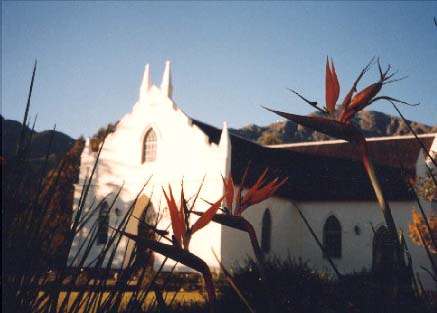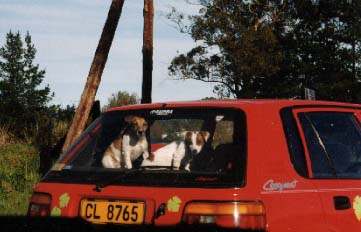Landscape

Monday, July 24 |
| I am sitting in an Internet cafe in Stellebosch, preferring to pay 10 Rand ($1.50) to write this with assurance that it will be sendable when I am finished. The connections on the farm are so slow, the computer sometimes goes to sleep half way. It is not a problem for a winery, they send messages using a special service, but for the kind of general Internet access which Hotmail requires, it is a real challenge. |
| Both Saturday and Sunday were beautiful days, despite some heavy winds. The sky was cloudless and in this weather you just have to imagine there is a beautiful view in every direction.. |
| Saturday morning I came into town with Nora and Rudy. The three of us enjoyed the university art museum. Rudy particularly enjoyed a long flight of stairs -- the typical houses here are all on ground level, so the most he gets is a step or two most places. There was an interesting collection given to the university by one local man, but on the whole there appear to be few South African artists who have distinguished themselves. Typically I guess artists from here, like those from many colonies, went to Europe to study and work. |
| I then went on to the local history museum, which is a mini-Jamestown, consisting of four houses. I was told they were all built by Dutch burghers, but I was also told that the third was Georgian and the fourth Victorian, so that left a puzzlement. I was also confused by a picture of Queen Victoria in the last house. The local "interpreters" have a lot to learn about interpretation. The one in the first house started off with a little spiel, but then quickly left before I got to ask her any questions. The one in the second house explained she was just a trainee. The poor one in the third house ended up with all my questions about houses 1, 2, and 3, and did a valiant job. The one in the fourth house is an intern from the university where she is studying tourism, and was the only white woman of the four. She had no idea why Queen Victoria was on the wall, and seemed puzzled that this might be a source of conflict if the house was own by a Dutch man at a time when the British were doing battle with the Boers. |
| To help me with these questions, Nora and Erhardt leant me a book called the REAL history of South Africa and indeed it is an excellent book, published just at Apartheid was ending, and making an effort to tell a more accurate picture of the interaction of whites and Africans in the early days of the colony. As Erhardt tells it, in his Afrikaner school days (he is now 33) he not only was led to believe that there were no blacks when the Europeans arrived in Capetown, but that the colony was essentially founded by the Dutch, when in fact, they arrived in 1649 and the Portuguese had been trading since 1488!. |
| Well, we have had some great discussions. Papa Spatz Sperling is more interested in my general historical knowledge, so I spent one tea time explaining the Opium war, and another the Crimean war (not my strong suit, but I have the basics) and the origins of World War I. We have had a variety of conversations about life in post-Apartheid Africa. It is interesting to me that there are such clear distinctions between coloreds and blacks. Papa will say things like "A black would never to that," referring to something a colored worker did, or "blacks don't fight like the coloreds." I was certainly aware that the pass system made these kinds of distinctions, but I did not know that they had come to be seen as cultural as well. We will drive by a corner and they will tell me if the people standing there are black or colored. I can not necessarily tell. |
| Saturday afternoon Papa Spatz (I call him papa because he calls me Auntie)and I drove up into the hills above the farm to look at all the newly planted seedlings. On the way we meant his head field worker, Peter, coming down with men in a truck. There was a long negotiation in Afrikaans which was friendly with lots of laughter on both sides. As we drove off, Papa shook his head. It seems Peter had announced last Saturday that the planting of the thousands of seedlings was finished and requested money to buy meet for a barbecue to thank the men who worked so hard. Papa Sperling had obliged. Now Peter was announcing that this Saturday the planting was REALLY finished, and that he would like something extra for himself. But what about the barbecue, Papa asked -- that was for the men, Peter explained. later that night I saw Peter leaving with a birthday cake left over from the parties. I am not sure if he got other recompense as well, but it is nice to know that within a year, noticeable green saplings will again dot the hillsides. |
| Sunday Erhardt, Nora and Rudy took me with them south to the coast and along the shoreline to look at whales which were spotted at a seaside resort called Hermanas. First we stopped at at botanical Garden where Rudi got to practice his tentative steps. He is up to ten steps unaided, but still prefers the security of his father's hand. |

| On the beach we had fish and chips, purchased in a shop next to the ubiquitous McDonalds, and then walked along the shore in the dazzling sunlight. A group of small boys offered us choral renditionis of various songs including, I am told, the national anthem. I enjoyed videotaping them and responded to their solicitation for money. It seems to me that we need to encourage initiative at every turn, even, as Erhardt pointed out, they offered more enthusiasm than precisions.We came home by way of a small farming community that had been settled by French Huguenots and is now a thriving resort town. |
| It was in all a fine day, with more to follow. |
|
| Well, that's it from a cool and rainy Europe. I hear it is unseasonably warm and sunny in Capetown, but that the grapes are suffering, so on their behalf I will hope to arrive in a cool and rainy South Africa next Tuesday. . |

This picture, by Erhardt Thiel appeared on a map of Capetown I bought in Frankfurt, Germany.




